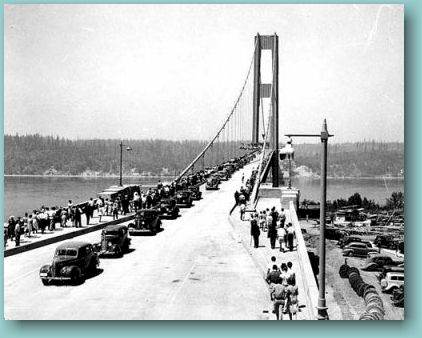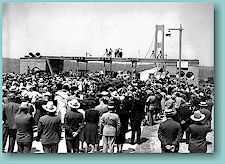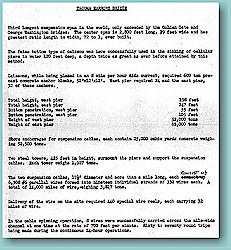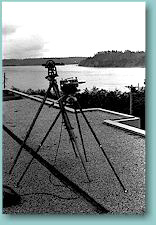Opening and Experiments to study 'ripple'
History of the Tacoma Narrows Bridge
|
|
Pt. 3: Opening and Experiments to study 'ripple'
The following images and text detail the opening and study of the movement of the Tacoma Narrows Bridge. Links to further pages on the Introduction, Construction, Collapse, Aftermath and Reconstruction are available at the bottom of the page. Text sources are listed in the bibliography at the end of the Reconstruction section. Image sources are described in the captions accompanying the images. The images are the exclusive right of the cited institutions (the University of Washington Libraries Special Collections Division and the Museum of History and Industry), please contact them for reproduction permission.
For additional images and documents relating to the history of the Tacoma Narrows Bridge, see the Tacoma Narrows Bridge Collection on the UW Libraries Digital Collections website.
|
|
The Tacoma Narrows Bridge opened to the public on July 1, 1940. It sprawled over its contemporaries with the third largest suspension span in the world. It had cost $6,400,000, was over a mile long, and had taken nineteen months to complete. An estimated 10,000 people attended the opening ceremony. Governor Clarence Martin extolled the many uses of the bridge emphasizing the economic and military importance of spanning the Tacoma Narrows.
|
|
The opening ceremonies suggested nothing of the eventual collapse of the bridge. There was no public indication that anyone expected anything but a bridge that would stand the test of time. However, while there were no expectations of collapse, movement began registering on the bridge during the construction of the floor section. This movement, in which the bridge deck rose and fell 1 1/3 feet above and below its normal position, created a sensation similar to motion sickness.
|
|
|
|
|
|
|
The toll bridge (nicknamed 'Galloping Gertie'), which cost 55 cents per car, 15 cents per extra passenger, and 15 cents for pedestrians, became something of a tourist attraction. Lines of up to 50 cars formed, waiting to 'ride' the bridge. Although engineers were convinced that the structure was safe, in late July 1940 the University of Washington, under the direction of Professor F.B. Farquharson, began filming the bridge's movement and conducting a series of experiments to devise methods to limit the movement.
|
|
Taking place in the basement of Guggenheim Hall (the engineering department's building), the experiments were done on a scale model of the bridge. Farquharson's team discovered motion on the model was diminished when anchor cables were attached from the center bottom of the approaches to the ground.
|
|
|
However, when installed on the actual bridge, the cables
|
|
snapped in the wind. Further experimentation suggested that drilling holes in the side girders would keep the wind from pushing and pulling on the bridge. Another suggestion was to install semicircular deflector shields as means of streamlining the side girders.
At the beginning of November 1940 the deflector shields were approved by the Washington Toll Bridge Authority and were to be installed in the coming weeks. The approval came too late for the bridge. To the shock of even those studying the bridge's movement, on November 7, 1940 the Tacoma Narrows Bridge collapse










